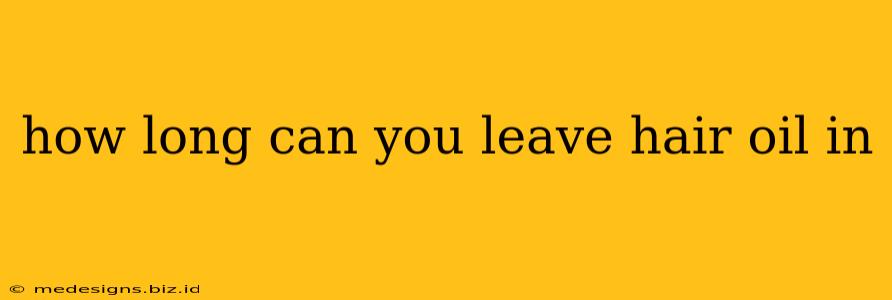Leaving hair oil in for the right amount of time is crucial for achieving healthy, shiny locks. Too little time, and you won't see the benefits; too long, and you could weigh your hair down or even cause buildup. This guide explores the optimal duration for various hair oiling methods and hair types.
Understanding the Benefits of Hair Oiling
Hair oiling, a practice dating back centuries, offers a plethora of benefits:
- Deep Conditioning: Oils penetrate the hair shaft, moisturizing and repairing damaged strands.
- Scalp Health: They nourish the scalp, promoting healthy hair growth and reducing dryness or itchiness.
- Shine and Smoothness: Oils coat the hair, resulting in a beautiful, glossy sheen and reducing frizz.
- Protection: They create a barrier against environmental stressors like UV rays and pollution.
How Long to Leave Hair Oil In: A Detailed Breakdown
The ideal oiling time depends on several factors:
- Your Hair Type: Fine or thin hair requires shorter oiling times to avoid weighing it down. Thick, coarse, or dry hair can benefit from longer treatments.
- The Type of Oil: Lighter oils like argan or jojoba oil absorb faster than heavier oils like coconut or castor oil.
- Your Desired Results: A quick treatment might address dryness, while a longer treatment can tackle deeper damage.
Short Oil Treatments (30 minutes to 1 hour):
This is ideal for:
- Fine or thin hair: Avoids excessive oil buildup.
- Quick hydration: Addresses minor dryness or frizz.
- Pre-shampoo treatment: Helps to loosen dirt and product buildup.
How to: Apply a small amount of oil, focusing on the ends. Leave it in for 30 minutes to an hour before washing your hair as usual.
Medium Oil Treatments (2-4 hours):
This is suitable for:
- Medium to thick hair: Provides deep conditioning without excessive weight.
- Addressing moderate dryness and damage: Improves hair's overall health and texture.
How to: Apply a moderate amount of oil, working it through your hair and scalp. Cover your hair with a shower cap to retain heat and enhance oil penetration.
Overnight Oil Treatments (8-12 hours):
This is best for:
- Very dry, damaged, or coarse hair: Offers the most intensive conditioning.
- Addressing split ends and breakage: Helps to repair and strengthen hair.
How to: Apply a generous amount of oil, focusing on the ends and scalp. Wrap your hair in a towel or use a shower cap to protect your bedding.
Choosing the Right Hair Oil
Various oils offer different benefits:
- Coconut Oil: Deeply moisturizing, excellent for dry and damaged hair.
- Argan Oil: Rich in antioxidants, improves shine and reduces frizz.
- Jojoba Oil: Similar to our natural sebum, balances scalp oil production.
- Castor Oil: Promotes hair growth, thickens hair, and conditions the scalp.
- Olive Oil: Moisturizes and conditions, good for all hair types.
Signs You've Left Hair Oil In Too Long
- Greasy or oily hair: If your hair feels excessively greasy or heavy, it's time to wash it.
- Build-up: Excessive oil buildup can lead to scalp irritation and clogged hair follicles.
- Flat hair: Oils can weigh down fine hair, making it appear limp and lifeless.
Washing Out Hair Oil
Use a clarifying shampoo to effectively remove all traces of oil from your hair and scalp. Follow up with a conditioner to maintain moisture balance.
Conclusion
Finding the perfect oiling time involves experimentation. Pay close attention to your hair's response and adjust the duration accordingly. Remember to choose the right oil for your hair type and desired results for optimal benefits. By following these guidelines, you'll be well on your way to healthier, shinier, and more manageable hair.
